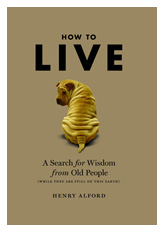How to Live: A Search for Wisdom from Old People (While They Are Still on this Earth)
By Henry Alford | Twelve | 272 pages, $23.99
A self-described “investigative humorist,” Henry Alford has seldom identified himself as such to his subjects, preferring the spontaneity of casual exchanges. But in the introduction to his first book, Municipal Bondage: One Man’s Anxiety-Producing Adventures in the Big City (1993), he shares his methodology with readers. “In almost every case,” he writes, “the people with whom I interact in this book did not know, at the time of interaction, that I was preparing to write about them. Posing as an individual devoid of ulterior motive, I entered these peoples’ lives and allowed my innocent mien and neurotic stammerings to put them off guard.”
 Both in this book and in its successor, Big Kiss: One Actor’s Desperate Attempt to Claw His Way to the Top (2000), Alford expends much of his considerable energy seeking points of comic departure. He assigns himself zany premises: watching an endless sequence of how-to videos, or chauffeuring the governor of Colorado around New York during the 1992 Democratic National Convention, even though he doesn’t really drive. These disingenuous exercises are, with few exceptions, as laborious and unfunny as they sound. Feigning innocence, the author peppers salespeople with oddball questions or tries to persuade restaurant managers to add his headshot to their photographic pantheon of movie stars. These people politely indulge him—it’s their job, after all. But the comedic returns are minimal.
Both in this book and in its successor, Big Kiss: One Actor’s Desperate Attempt to Claw His Way to the Top (2000), Alford expends much of his considerable energy seeking points of comic departure. He assigns himself zany premises: watching an endless sequence of how-to videos, or chauffeuring the governor of Colorado around New York during the 1992 Democratic National Convention, even though he doesn’t really drive. These disingenuous exercises are, with few exceptions, as laborious and unfunny as they sound. Feigning innocence, the author peppers salespeople with oddball questions or tries to persuade restaurant managers to add his headshot to their photographic pantheon of movie stars. These people politely indulge him—it’s their job, after all. But the comedic returns are minimal.
Alford’s claim to investigative journalism is customarily delivered with a wink. But in his new book, he does break with his standard practice. In How to Live: A Search for Wisdom from Old People (While They Are Still on this Earth), he is upfront with his subjects. “I sent out hundreds of emails,” he writes, “presenting myself as a journalist hot on the path of wisdom.”
How to Live also benefits from a tighter focus and the author’s increased willingness to cede the spotlight to his subjects. Alford delights in his quest, dipping into wisdom-related texts at the library, phoning experts, and traveling around the country to interview the elderly. He meets both the famous (Edward Albee, Harold Bloom) and the obscure (including Alford’s mother and stepfather, whose separation the book chonicles), and several of his conversations reveal the hidden possibilities of old age. These are enough to shatter the scenario he airs early on: “We tend to think of life after seventy–outside of medical ailments, of course–as being soft and muzzy and fairly static: lots of cardigan sweaters and an increasingly housebound devotion to a small, irritable pet.”
If Alford accepts this dreary picture of old age too unquestioningly, at least at the outset, it is because the success of his book depends upon it. He is counting on surprising readers with the news that not everyone retires at sixty-five, that life goes on and may even improve.
As the data piles up, Alford is quick to acknowledge the difficulty of defining wisdom. This is fair. Yet How to Live boils over into such kitschy departments as deathbed confessions and near-death experiences. And throughout, Alford lays on the aphorisms in thick drifts; the book is an orgy of pithiness for all ages. “Yes, an interest in succinctness bespeaks a short attention span,” he writes. “But there’s nothing more powerful than the artful distillation of an entire philosophy down into a few words.” The irony is that How to Live is too long by half. Older readers, recalling the slog through Alford’s more unjustifiable inclusions, may find themselves wishing for some of their time back.
For all this distraction, Alford does eventually arrive at his definition of wisdom—249 pages after beginning, sixty-seven pages after Albee asks for it. Or rather, he identifies the five traits that comprise it: reciprocity, doubt, nonattachment, discretion, and acting for a social good. He also notes that being able to define wisdom is not the same thing as possessing it. “Knowing what to overlook, knowing when not to fixate, extinguishing the will–I’d love to be able to call any of these skills my own,” he writes. “Not having them has certainly been its own toboggan ride. Man plans, and God laughs; but man fixates, and God writes and produces his own HBO comedy special.”
Alford, of course, is not the only one operating with a wisdom deficit. In the book’s final chapter, he visits Ashleigh Brilliant, a seventy-five-year-old published epigrammist, with ten thousand to his name. Alford rightly lets the interview stand without comment. What comes through, however, is that this man who spends his time cranking out aphorisms is no wiser than anyone else; he resides not in some enlightened paradise but in a cluttered Santa Barbara house in the company of his irritating wife. And just maybe, since life is short, the artful distillation of entire philosophies is not the best use of his time.
Gregory Beyer is a journalist whose work has appeared in The New York Times and the Los Angeles Times.
